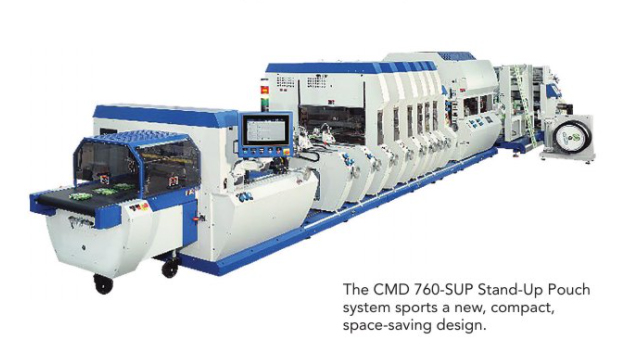Defining Reliability in Pouch Equipment
- Published: July 13, 2021
When it comes to total cost of ownership and profitability, all pouch equipment is not created equal
By: Scott Fuller, Product Line Manager, Pouch and Intermittent-Motion Equipment at CMD Corporation

Reliability is the number one desired machine attribute for pouch converters, but this deceptively simple statement can sometimes be misunderstood.
Reliability isn’t only about the sturdiness of the machine. It means that production will be reliable; that pouches will be of consistent quality; that downtime, especially unexpected stoppages, are minimized. It’s about product going out the door, on time, at the expected cost.
Similar to how we expect our automobiles to be reliable; to consistently run and give us as little grief as possible, converters expect reliability in their equipment.
What are some gauges for reliability?
1. The machine should be well-made – designed to provide process stability for many years – and to do so without frequent operator intervention. Obviously, to achieve optimal pay-back the equipment should last for years, even decades. But, in that time, the stability of the process should not degrade. Some of this comes from the overall build quality of the machine, the raw materials and the workmanship. Some of this comes from the design of the machine.
Some converters have the good fortune of having in-house experts that keep lesser quality machinery running. They fix and tinker, adjusting springs and settings, sometimes even rebuilding sections of machines to get them to operate to the converter’s needs and expectations. This is a vanishing skill set, and more often than not, converters are faced with a shrinking labor pool of skilled workers. Entry-level operators and frequent turnover require a reliable machine that runs efficiently and effectively, day in and day out, without the need for frequent maintenance or monitoring.
The long-term stability and sustained operationof the machine needs to be considered at thedesignstage.
- Simplified mechanical design with fewer moving parts results in fewer opportunities for wear:
- Fewer maintenance touchpoints mean that you spend less time with preventive maintenance tasks. Maintenance touch points should be designed for rapid corrections and changeovers.
2. The machine should offer low total cost of ownership
A reliable pouch machine benefits your bottom line by offering truly shorter changeovers and a meaningful reduction in downtime associated with both preventive maintenance tasks, as well as unplanned downtime. The end result is that your machine will be producing sellable product for more of the time, resulting in a quicker payback and lower cost of ownership.
3. The machine performs to expectations, which includes keeping scrap rates to a specified threshold while while reliably producing consistently high-quality pouches
The machine is an asset, a tool, that needs to deliver a specific amount of product in a specified amount of time (throughput.) It must have speed capabilities that will maximize productivity. Speed is important as long as quality is assured, and waste is minimized (efficiency.) It is expected to make a quality pouch, and is relied upon to play its part in getting orders out the door on time.
Pouch machines need to be designed with one goal in mind; to provide the most stable process available in the market today, requiring fewer operator interventions during a production run. This results in less scrap during the run.
4. The machine is reliably simple to operate and maintain
Keeping operation and maintenance simple is a sure way to cut costs and save money.
Easy to operate touch screen controls and machine adjustments contribute to product quality, minimize downtime and support a reliable process control. Pouch equipment has come a long way, and quick-change features significantly reducestart-up and changeover time.
Challenges with recruiting and retaining operators makes simple set-up and operation imperative. Machinery that is straightforward to operate, with recipes and adjustments that are easily repeated, help mitigate the challenges converters face with operator turnover.
Affordable/accessible spare parts and reliable, responsive service are also an important component to simplified, reliable operation. Converters look for low cost and accessibility for common wear parts. The OEM that provides reliable, consultative service, including providing the tools for preventive maintenance to avoid unscheduled downtime, is a valuable partner.
About the Author
Scott Fuller is the product line manager, pouch and intermittent-motion equipment at CMD Corporation. Fuller has been with CMD since 2009 and has 30+ years of experience in the film, bag and pouch converting industry, including experience in Six-Sigma/continuous improvement; equipment technology development; and new package design.



